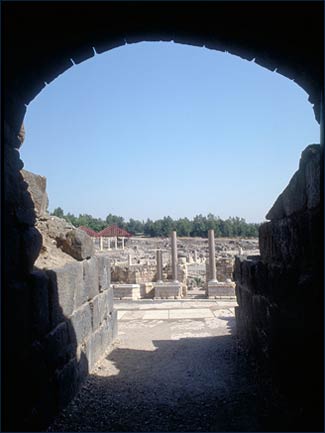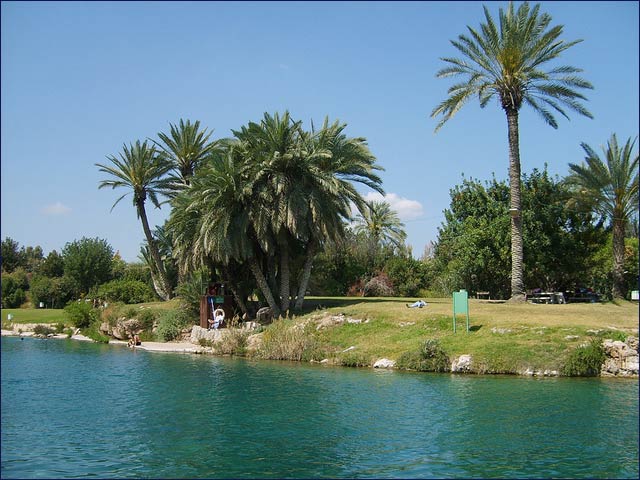By Avigayil Kadesh
Beit She’an (“House of Tranquility”), a city on Israel’s central-northeast border with Jordan, in its Roman heyday was a regional hub with 30,000 to 40,000 inhabitants due to its strategic -- and picturesque -- location at the junction of the Jordan River Valley and the Jezreel Valley. Today it is home to 17,000 residents.
Licensed tour guide Moshe Friedman explains: “Modern Beit She’an is a provincial town, but for much of history it was a major capital because the ground is very fertile and it’s at a crossroads geographically.”
Today it is a favorite tourist stop because you can explore the vast archeological park with restored ruins of a Roman-built city – complete with a 7,000-seat Roman theater, an amphitheater where gladiators fought, a Byzantine bathhouse and two colonnaded streets -- and five minutes later go out to eat at a (kosher) McDonalds in the shopping mall nearby.

Beit She’an National Park viewed through the Roman theater ruins. Photo courtesy of Israel Tourism MinistryArcheologists have determined that Beit She’an was first settled in the Chalcolithic period, about 5,000 to 6,000 years ago. About 3,500 years ago the Egyptians took control, followed a few hundred years later by the Philistines and still later the Greeks, Romans, Crusaders and Mamluks.
“Beit She’an sits on Kings Way, a natural roadway from Egypt to Damascus, so it was important during the Crusader period as a connection point between the culture center of Egypt and the mercantile center in Damascus,” says Friedman. “Crusader kings sent messengers along this roadway.”
It reached its peak with the arrival of the Romans, as evidenced in the archeological park. Tour guide Shalom Pollack says the park is “a big wow for anyone above seven or eight years old,” and at night there is a sound-and-light show.
The 11 peaks of Mount Gilboa
Also impressive are the vistas from nearby Mount Gilboa, which boasts 11 peaks and lots of picnic grounds.

Mount Gilboa
Photo courtesy of Wikimedia Commons “I like to take people to the top of Mount Gilboa,” says Pollack. “The view there is amazing -- you can see the whole Beit She’an Valley and Jezreel Valley, and take a short hike on the mountain paths, where King Saul and his son Jonathan died in the biblical battle with the Philistines.”
In Kibbutz Heftziba, at the foot of the northern slopes of Gilboa, Beit Alfa Synagogue National Park houses Israel’s best-preserved synagogue mosaic floor from the sixth century.
A Roman-era bridge, a Crusader fortress, a mosque from the Mamluk period, a Turkish government house, an Ottoman fort and several basalt stone houses from the period of Arab conquest of Beit She’an are all open to tourists.
The Belvoir (or Kochav HaYarden -- Star of the Jordan) Park is dominated by a Crusader castle, built around 1140, perched high above the Jordan valley about nine miles uphill from the Beit She’an Valley. Belvoir affords a 270-degree view south over the Jordan Valley, north to the Sea of Galilee and the Golan and west over the Galilee and Beit She’an/Jezreel valleys. There is a sculpture park on the grounds, and just north is a feeding station set up to strengthen Israel’s Griffon vulture population.
Modern attractions
In the Beit She’an area on the grounds of Kibbutz Nir David are two popular nature and wildlife sites: Sachne-Gan Hashlosha and Gan Garoo.

Sachne-Gan Hashlosha National Park at Kibbutz Nir David
Photo courtesy of Wikimedia Commons Sachne is a series of natural pools fed by hot springs and a stream with mini-waterfalls. “It’s very refreshing, when it’s warm outside, to take a dip in the stream, and the picnic area is great for families, especially in summertime,” says Pollack.
Gan Garoo, a unique Australian park, lets visitors feed and pet the free-roaming kangaroos and cockatoos, and watch the koalas, cassowary and flying fox.
Also on the kibbutz is a museum devoted to the tower-and-stockade settlements built by Zionist immigrants during the British Mandate in the late 1930s to early 1940s. “This gives you a feeling of what it was like to be a pioneer in the valley,” says Pollack. Nir David was one of 52 tower-and-stockade settlements in Israel.

Feeding the residents at Gan Garoo Pollack recommends a tour of nearby Kibbutz Sde Eliyahu’s Bio-Bee Biological Systems, which sells specially bred fruit flies, bees, and other insects, as well as nesting owls, used on farms in 30 countries as natural pest control. Kids can feed wild donkeys here.
For a different water experience in the Beit She’an area, splash around in the natural springs at Emek Hakibbutzim.
Pollack suggests buying lunch at Kibbutz Sde Eliyahu or Kibbutz Tirat Zvi for an inexpensive and authentic kibbutz dining experience. Reasonably priced lodgings are available at many area kibbutzim, and also through the Israel Youth Hostel Association system.